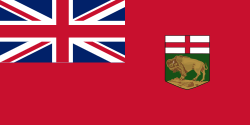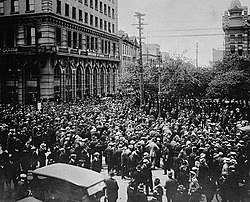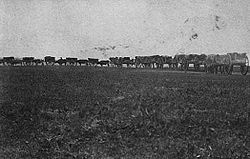Manitoba
Manitoba is a province of Canada that is roughly in the country's centre.
|
| |
| Coordinates: 55°N 97°W / 55°N 97°W[1]Coordinates: 55°N 97°W / 55°N 97°W[1] | |
| Country | Canada |
| Confederation | 15 July 1870[3] (5th, with Northwest Territories) |
| Capital | Winnipeg |
| Largest city | Winnipeg |
| Largest metro | Winnipeg Region |
| Government | |
| • Type | Parliamentary constitutional monarchy |
| • Lieutenant Governor | Anita Neville |
| • Premier | Wab Kinew (New Democrat) |
| Legislature | Legislative Assembly of Manitoba |
| Federal representation | Parliament of Canada |
| House seats | 14 of 338 (4.1%) |
| Senate seats | 6 of 105 (5.7%) |
| Area | |
| • Total | 647,797 km2 (250,116 sq mi) |
| • Land | 553,556 km2 (213,729 sq mi) |
| • Water | 94,241 km2 (36,387 sq mi) 14.5% |
| • Rank | Ranked 8th |
| 6.5% of Canada | |
| Population (2021) | |
| • Total | 1,342,153[2] |
| • Estimate (2025 Q1) | 1,504,023 [5] |
| • Rank | Ranked 5th |
| GDP | |
| • Rank | 6th |
| • Total (2015) | C$65.862 billion[7] |
| • Per capita | C$50,820 (9th) |
| Time zone | UTC−6 (Central) |
| • Summer (DST) | UTC−5 (Central DST) |
| Rankings include all provinces and territories | |
Manitoba is Canada's sixth-largest province, with an area of 647,797 square kilometres (250,116 sq mi). It has the fifth-largest number of people, at 1,504,023 in 2025, and its people are called "Manitobans".
History
People have been living in Manitoba for thousands of years. Both the Hudson's Bay Company from England and many people from France moved to Manitoba during the 17th, 18th, and 19th centuries. Manitobabecame part of the Northwest Territories in 1869. The Red River Rebellion, which was started by Louis Riel, began there.
Manitoba became part of Canada on 12 May 1870. The province then included only the southern part, which is near the United States, until parts of the Northwest Territories were later added.
Government
The capital of Manitoba is Winnipeg. Other large cities in Manitoba are Steinbach and Brandon.
The people of Manitoba elect a legislature. The leader of the government, who is called the premier, is the leader of the largest party in the legislature. There is also a lieutenant governor, who represents the British monarch.
The main political parties in Manitoba are the New Democratic Party, the Progressive Conservative Party, and the Liberal Party.
Manitoba Media
Crowds gathering outside the old City Hall during the Winnipeg general strike, 21 June 1919
Aerial view of the Red River Floodway
Deep Lake at Riding Mountain National Park
The Manitoba Legislative Building, meeting place of the Legislative Assembly of Manitoba
Union Station in Winnipeg
References
- ↑ Template:Cite cgndb
- ↑ Statistics Canada. Data table, Census Profile, 2021 Census of Population – Manitoba [archived 10 February 2022; cited February 9, 2022].
- ↑ Brawn, Dale. The Court of Queen's Bench of Manitoba, 1870–1950: A Biographical History. University of Toronto Press; 2006. ISBN 978-0-8020-9225-0. p. 22.
- ↑ Statistics Canada. Land and freshwater area, by province and territory [cited 25 August 2023].
- ↑ Statistics Canada. Population estimates, quarterly; March 19, 2025.
- ↑ University of Ottawa. The legal context of Canada's official languages [archived 10 October 2017; cited 7 March 2019].
- ↑ Statistics Canada. Gross domestic product, expenditure-based, by province and territory (2015); 9 November 2016 [archived 19 September 2012].
Other websites
| Wikivoyage has a travel guide about: Manitoba |
- Manitoba at the Open Directory Project











